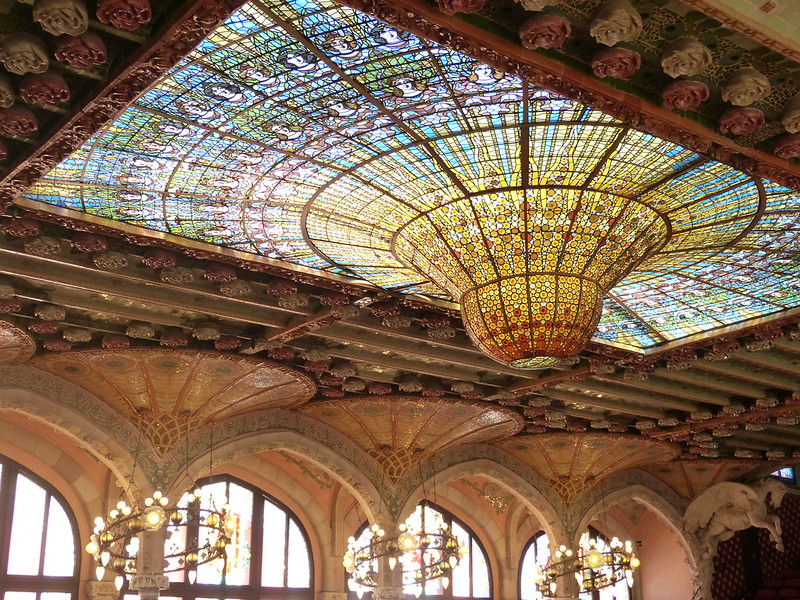"Against the grey traditional houses all round it, the Palau de la Música Catalana, the city's concert hall, has all the appearances of an aberration, a dream building paid for by a mad king, or a capricious count, designed by an architect with more imagination than good sense. Somehow, it doesn't look serious."
"Homage to Barcelona", a half memoir half travelogue written by Irish writer Colm Tóibín, makes it clear that in order to understand Barcelona you need to understand Catalonia first. He explains very well how the Modernist style associated to the city is also intrinsically linked to Catalan nationalism and politics, through the figures of a few important architects who were also influential politicians. Domènech i Montaner, the architect who designed this UNESCO-listed concert hall in the centre of Barcelona, is the political counterpart to Antoni Gaudí, who was notoriously more interested in religion. After reading this book, which is an excellent introduction to the city of Barcelona, to its identity and its history, I feel like I understand the city a lot better. Indeed, certain modernist architecture in the city, including Sagrada Familia, can give the impression of a capricious aberration that you learn to love as part of the extravagant fascinating identity of Barcelona.
 |
| The main concert hall of the Palau de la Música |
If, like me, you can't get enough modernist architecture in Barcelona, you should follow my advice and visit Palau de la Música Catalana. It's flamboyant, eccentric, colourful, and definitely worth your time. It's slightly off the beaten track, as most tourists stick to Sagrada Familia, Casa Battló and Parc Güell, so most likely you won't need to book your guided visit, which is a plus in Barcelona. I stopped by just before lunch on a summer day, which is when the city is full of tourists just about everywhere, and booked whichever tour I wanted.
The concert hall is cramped between tall, dull buildings in the centre of Barcelona, in the neighbourhood of La Ribera to be precise. You struggle to notice the details of the decorations from the narrow pedestrian street, but once inside everything will be spacious and beautiful. Because of its position in between other buildings, light was going to be a problem. The solution the architect found was to build an innovative inverted dome made of stained glass, which has now become one of the main features of the building. Thanks to it, during the day the concert hall is entirely illuminated by natural light. How amazing is that?
 |
| The famous inverted glass dome |
The inverted glass dome and its beautiful angels will take all of your attention once you're inside the main hall: the structure is so colourful, bright and magnetic, not to mention so carefully studied and gracious.
 |
| The inverted stained glass dome in the main hall |
When I stopped staring at the dome from every possible angle, I said to myself that I had to look around a little bit more. I started to notice the roses on the ceiling, and the statues of the muses on the stage, awkwardly coming out of the wall and offering a natural backstage for any concert.
 |
| Muses on the stage in the Palau de la Música Catalana |
Some of the details inside the concert hall show how imaginative the modernist movement was: the chandeliers, for instance, run around pillars and are not straight, but that's on purpose! There are also decorations in the shape of peacock feathers on the ceiling, and colourful mosaics on the balcony that looks outside. It's incredible how every small corner is carefully decorated according to the main architect's ideas, with strong symbolism connected to Catalan identity. I finished my visit feeling satisfied and happy to have had the opportunity to see this marvel of modern architecture.
 |
| Peacock feathers and roses on the ceiling of the main concert hall |
Overall I think that Palau de la Música Catalana is as interesting and inspiring as other more famous modernist buildings in Barcelona and it should deserve more attention. I wished that more people included it in their itinerary! After all, modernism is not Gaudí only. I've seen buildings around the city that are as eccentric and worth being admired as any of Gaudí's much praised flights of fancy.
 |
| Palau de la Musica Catalana |
Guided visits of the Palau de la Música Catalana are offered every 30 minutes during the opening times, and you can choose between Catalan, Spanish, English, French and Russian. They cost 18€ (11€ for concessions) and they last 55 minutes.
PS: This post contains an affiliate link, which means that if you are interested in buying the book I mentioned, you should do it from the link I provide. I get a small commission if you do, but the price for you doesn't change at all. Of course, the opinions are always mine, as I would never write on this blog about a book that I didn't like!
Oh my God that dome is just pure genius and art it's absolutely incredible!!
ReplyDelete
ReplyDelete